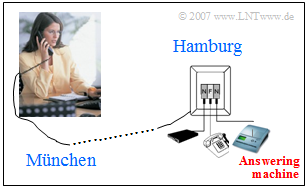Difference between revisions of "Aufgaben:Exercise 1.1Z: ISDN Connection"
From LNTwww
m (Text replacement - "[[Signaldarstellung/" to "[[Signal_Representation/") |
|||
| Line 1: | Line 1: | ||
{{quiz-Header|Buchseite=Signaldarstellung/Prinzip der Nachrichtenübertragung}} | {{quiz-Header|Buchseite=Signaldarstellung/Prinzip der Nachrichtenübertragung}} | ||
| − | [[File:EN_Sig_Z_1_1.png|right|frame| | + | [[File:EN_Sig_Z_1_1.png|right|frame|a telephone connection scenario]] |
| − | + | We consider the scenario shown in the picture: | |
| − | + | A woman from Munich dials a number in Hamburg with her ISDN phone. However, she cannot reach the person she wants to talk to, so she leaves him a message on tape. | |
| − | + | The distortion-free connection is fully described by | |
| − | + | * a damping factor $\alpha$, | |
| − | + | * a term $\tau$, and | |
| − | :* | + | :* the current signal-to-noise ratio (SNR) |
| − | |||
| Line 20: | Line 19: | ||
| − | '' | + | ''Notes:'' The task shall establish a relation between this real scenario and the functional units of a general message transmission system mentioned in [[Signal_Representation/Prinzip_der_Nachrichtenübertragung#Blockschaltbild_eines_Nachrichten.C3.BCbertragungssystems|Theorieteil]] . |
| − | === | + | ===Questions=== |
<quiz display=simple> | <quiz display=simple> | ||
| − | { | + | {Which of the statements are true regarding source and sender? |
|type="[]"} | |type="[]"} | ||
| − | + | + | + The news source is the caller. The source signal ${q(t)}$ is the acoustic wave of her voice signal. |
| − | + | + | + The unit designated "transmitter" contains, among other things, a signal converter and a modulator. |
| − | - | + | - The transmit signal $s(t)$ is analog. |
| − | { | + | {Which of the statements are true regarding recipients and sinks? |
|type="[]"} | |type="[]"} | ||
| − | - | + | - The received signal $r(t)$ is digital. |
| − | - | + | - The news sink is the telephone set in Hamburg. |
| − | + | + | + The news sink is the answering machine. |
| − | + | + | + The following applies $v(t) = \alpha \cdot q(t - \tau ) + {n(t)}$. |
| − | - | + | - There is an ideal transmission system. |
| Line 47: | Line 46: | ||
</quiz> | </quiz> | ||
| − | === | + | ===Solutions=== |
{{ML-Kopf}} | {{ML-Kopf}} | ||
| − | '''(1)''' | + | '''(1)''' The <first two statements</u> are correct: |
*Das Sprachsignal ${q(t)}$ muss zunächst in ein elektrisches Signal gewandelt und anschließend für die Übertragung aufbereitet werden. | *Das Sprachsignal ${q(t)}$ muss zunächst in ein elektrisches Signal gewandelt und anschließend für die Übertragung aufbereitet werden. | ||
*Bei ISDN ist das Sendesignal ${s(t)}$ digital. | *Bei ISDN ist das Sendesignal ${s(t)}$ digital. | ||
Revision as of 13:18, 8 August 2020
We consider the scenario shown in the picture:
A woman from Munich dials a number in Hamburg with her ISDN phone. However, she cannot reach the person she wants to talk to, so she leaves him a message on tape.
The distortion-free connection is fully described by
- a damping factor $\alpha$,
- a term $\tau$, and
- the current signal-to-noise ratio (SNR)
Notes: The task shall establish a relation between this real scenario and the functional units of a general message transmission system mentioned in Theorieteil .
Questions
Solutions
(1) The <first two statements are correct:
- Das Sprachsignal ${q(t)}$ muss zunächst in ein elektrisches Signal gewandelt und anschließend für die Übertragung aufbereitet werden.
- Bei ISDN ist das Sendesignal ${s(t)}$ digital.
(2) Richtig sind die Lösungsvorschläge 3 und 4:
- Das Empfangssignal ${r(t)}$ ist aufgrund des unvermeidbaren thermischen Rauschens stets analog.
- Die Nachrichtensinke ist der Anrufbeantworter.
- Bei einem idealen Übertragungssystem müsste $v(t) = {q(t)}$ gelten.
- Aufgrund des additiven Rauschterms ${n(t)}$, der Dämpfung $\alpha$ und der Laufzeit $\tau$ gilt jedoch hier:
- $$v(t) = \alpha \cdot q ( t - \tau) + n(t).$$
- Es handelt sich nach unseren Definitionen um ein verzerrungsfreies System.
